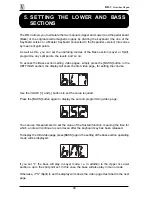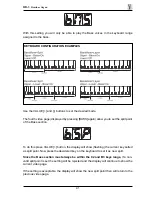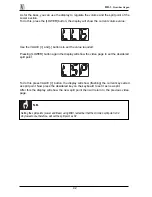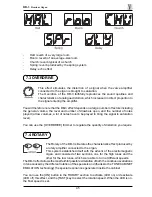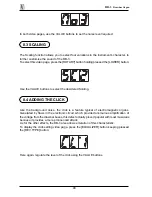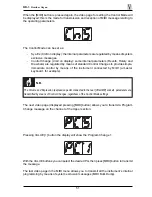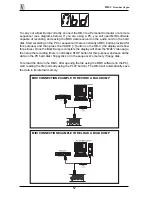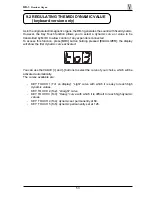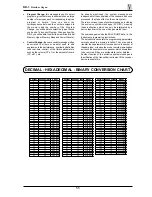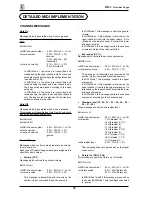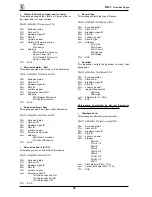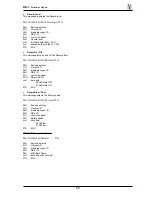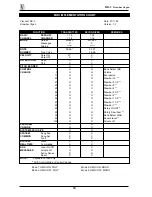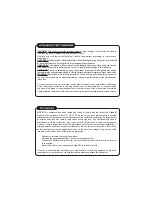
DB-3
Drawbar Organ
ABOUT MIDI
WHAT IS MIDI?
The MIDI (Musical Instrument Digital Interface) allows
instruments of different makes and types to communicate
with each other by means of this clearly specified protocol
of codes. This makes it possible to create systems of
MIDI instruments which offer much better versatility and
control than can be achieved with separate instruments.
To make this communication possible, all MIDI
instruments are equipped with two or three 5 pin DIN
connectors marked:
- MIDI IN:
By means of this jack, the device
receives the MIDI data emitted by other
units.
- MIDI OUT:
By means of this jack the device sends
the MIDI data it has generated to other
units.
- MIDI THRU:
This jack, used to connect several units
in series, emits the MIDI data exactly
as they are received by the respective
MIDI IN port.
For example, most instruments equipped with MIDI
interface transmit MIDI messages which specify which
note has been played and with what dynamics by means
of the MIDI OUT connector.
If this connector is connected to the MIDI IN of another
MIDI instrument, such as a synthesiser or an expander,
the connected instrument will give a precise response
to the notes played on the transmitter instrument.
This allows you actually to play two instruments at the
same time, and obtain special multi-instrument sounds.
CAUTIONS
Always use top quality cables for the MIDI connections from and
to the DB-3. We also advise the use of cables no more than 5
metres long.
It is possible to use the MIDI THRU to connect two or more MIDI
devices, but in practice the limit is 5 units. This is because as the
signal path becomes longer, the signal deteriorates and the
messages can no longer be received correctly.
MIDI Channels
The MIDI is able to transmit a multitude of digital data by
means of a single cable and thus a single connector,
thanks to the MIDI channels.
There are 16 MIDI channels, so MIDI messages are
processed when the channels of the receiver and
transmitter instruments are the same.
The DB-3 is able to receive and transmit information on
a maximun of 3 MIDI channels simultaneously: one for
the upper manual, one for the lower manual and one for
the BASS section (see also MIDI Mode function). The
data relating to the instrument’s general information (the
Reverb parameter, for example) are sent on the channel
associated to the upper manual.
MAIN MIDI MESSAGES TRANSMITTED AND RECEIVED BY
THE DB-3
The same type of transfer of information is used to
record MIDI sequences. A sequencer can be used to
record the MIDI data transmitted by the DB-3 or any other
instrument. When these recorded data are sent to the
DB-3, it will automatically play back the recorded
performance.
The MIDI includes various types of messages used to
communicate various types of data. The MIDI messages
can be subdivided into messages handled separately
on each channel, and messages dedicated to the entire
system.
The channel messages include:
•
Note On: this message is transmitted when a note
is played, i.e. when a keyboard key is pressed. Each
Note On message includes the following codes:
Note On: when a key has been pressed;
Note Number: the key and thus the relative note
which has been played;
Velocity: dynamic of the note (the force with which
the key had been pressed).
Note messages are expressed as a number from 0
to 127, with Middle C represented by the number
60. Since its dynamic value is fixed, the OB5 always
sets the Velocity value as 64.
•
Note Off: this message is transmitted when the key
pressed previously is released. When it is received,
the sound of the note of that key is deactivated. Each
Note Off message includes the following codes:
Note Off: a key has been released;
Note Number: which key has been released;
Velocity: dynamic (amount of force) with which it has
been released.
N.B.:
A Note On message with Velocity=0 is considered as a
Note Off message.
54
Содержание DB-3
Страница 1: ...DB 3 User Manual ...
Страница 4: ......
Страница 10: ...DB 3 Drawbar Organ 3 3 CONNECTION EXAMPLES 36 ...

